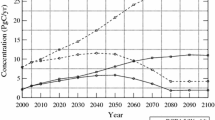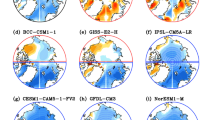Abstract
In this study, a coupled atmosphere-surface “climate feedback-response analysis method” (CFRAM) was applied to the slab ocean model version of the NCAR CCSM3.0 to understand the tropospheric warming due to a doubling of CO2 concentration through quantifying the contributions of each climate feedback process. It is shown that the tropospheric warming displays distinct meridional and vertical patterns that are in a good agreement with the multi-model mean projection from the IPCC AR4. In the tropics, the warming in the upper troposphere is stronger than in the lower troposphere, leading to a decrease in temperature lapse rate, whereas in high latitudes the opposite it true. In terms of meridional contrast, the lower tropospheric warming in the tropics is weaker than that in high latitudes, resulting in a weakened meridional temperature gradient. In the upper troposphere the meridional temperature gradient is enhanced due to much stronger warming in the tropics than in high latitudes. Using the CFRAM method, we analyzed both radiative feedbacks, which have been emphasized in previous climate feedback analysis, and non-radiative feedbacks. It is shown that non-radiative (radiative) feedbacks are the major contributors to the temperature lapse rate decrease (increase) in the tropical (polar) region. Atmospheric convection is the leading contributor to temperature lapse rate decrease in the tropics. The cloud feedback also has non-negligible contributions. In the polar region, water vapor feedback is the main contributor to the temperature lapse rate increase, followed by albedo feedback and CO2 forcing. The decrease of meridional temperature gradient in the lower troposphere is mainly due to strong cooling from convection and cloud feedback in the tropics and the strong warming from albedo feedback in the polar region. The strengthening of meridional temperature gradient in the upper troposphere can be attributed to the warming associated with convection and cloud feedback in the tropics. Since convection is the leading contributor to the warming differences between tropical lower and upper troposphere, and between the tropical and polar regions, this study indicates that tropical convection plays a critical role in determining the climate sensitivity. In addition, the CFRAM analysis shows that convective process and water vapor feedback are the two major contributors to the tropical upper troposphere temperature change, indicating that the excessive upper tropospheric warming in the IPCC AR4 models may be due to overestimated warming from convective process or underestimated cooling due to water vapor feedback.








Similar content being viewed by others
References
Alexeev VA, Langen PL, Bates JR (2005) Polar amplification of surface warming on an aquaplanet in ‘‘ghost forcing’’ experiments without sea ice feedbacks. Clim Dyn 24:655–666
Bintanja R, Graversen R, Hazeleger W (2011) Arctic winter warming amplified by the thermal inversion and consequent low infrared cooling to space. Nat Geosci 4:758–761
Bitz CM, Fu Q (2008) Arctic warming aloft is data set dependent. Nature 455:E3–E4
Bony S et al (2006) How well do we understand and evaluate climate feedback processes? J Clim 19:3445–3482
Boville BA, Rasch PJ, Hack JJ, McCaa JM (2006) Representation of clouds and precipitation processes in the Community Atmosphere Model version 3 (CAM3). J Clim 19:2188–2198
Butler AH, Thompson DWJ, Heikes R (2010) The steady-state atmospheric circulation response to climate change-like thermal forcings in a simple general circulation model. J Clim 23:3474–3496. doi:10.1175/2010JCLI3228.1
Cai M (2006) Dynamical greenhouse-plus feedback and polar warming amplification. Part I: a dry radiative-transportive climate model. Clim Dyn 26:661–675
Cai M, Lu JH (2007) Dynamical greenhouse-plus feedback and polar warming amplification. Part II: meridional and vertical asymmetries of the global warming. Clim Dyn 29:375–391
Cai M, Lu JH (2009) A new framework for isolating individual feedback processes in coupled general circulation climate models. Part II: method demonstrations and comparisons. Clim Dyn. doi:10.1007/s00382-008-0424-4
Cai M, Tung K (2012) Robustness of dynamical feedbacks from radiative forcing: 2% solar versus 2 × CO2 Experiments in an idealized GCM. J Atmos Sci. doi:10.1175/JAS-D-11-0117.1 (in press)
Cess RD et al (1990) Intercomparison and interpretation of cloud-climate feedback processes in nineteen atmospheric general circulation models. J Geophys Res 95:16601–16615
Cess RD et al (1991) Interpretation of snow-climate feedback as produced by 17 general circulation models. Science 253:888–892
Chung CE, Räisänen P (2011) Origin of the Arctic warming in climate models. Geophys Res Lett 38:L21704. doi:10.1029/2011GL049816
Collins WD et al (2006a) The Community Climate System Model version 3 (CCSM3). J Clim 19:2122–2143
Collins WD et al (2006b) The formulation and atmospheric simulation of the Community Atmosphere Model version 3 (CAM3). J Clim 19:2144–2161
Colman RA (2001) On the vertical extent of atmospheric feedbacks. Clim Dyn 17:391–405. doi:10.1007/s003820000111
Colman RA, McAvaney BJ (1997) A study of general circulation model climate feedbacks determined from perturbed SST experiments. J Geophys Res 102:19383–19402
Danabasoglu G, Gent PR (2009) Equilibrium climate sensitivity: is it accurate to use a slab ocean model? J Clim 22:2494–2499
Deser C, Tomas R, Alexander M, Lawrence D (2010) The seasonal atmospheric response to projected Arctic sea ice loss in the late twenty-first century. J Clim 23:333–351
Francis JA, Hunter E (2007) Changes in the fabric of the Arctic’s greenhouse blanket. Environ Res Lett 2. doi:10.1088/1748-9326/2/4/045011
Fu Q, Johanson CM (2005) Satellite-derived vertical dependence of tropical tropospheric temperature trends. Geophys Res Lett 32:L10703. doi:10.1029/2004GL022266
Fu Q, Manabe S, Johanson CM (2011) On the warming in the tropical upper troposphere: models versus observations. Geophys Res Lett 38:L15704. doi:10.1029/2011GL048101
Grant AN, Brönnimann S, Haimberger L (2008) Recent Arctic warming vertical structure contested. Nature 455:E2–E3
Graversen RG, Mauritsen T, Tjernström M, Källén E, Svensson G (2008) Vertical structure of recent Arctic warming. Nature 451:53–56
Hall A, Manabe S (1999) The role of water vapour feedback in unperturbed climate variability and global warming. J Clim 12:2327–2346
Hartmann DL, Larson K (2002) An important constraint on tropical cloud-climate feedback. Geophys Res Lett 29:1951–1954. doi:10.1029/2002GL015835
Held IM (1993) Large-scale dynamics and global warming. Bull Am Meteorol Soc 74:228–241. doi:10.1175/1520-0477
Holland MM, Bitz CM (2003) Polar amplifications of climate change in coupled models. Clim Dyn 21:221–232
Intergovernmental Panel on Climate Change (IPCC) (2007) Climate change 2007: the physical science basis. In: Solomon S et al. (eds.) Cambridge University Press, Cambridge, UK
Kiehl JT, Shields CA, Hack JJ, Collins WD (2006) The climate sensitivity of the Community Climate System Model Version 3 (CCSM3). J Clim 19:2584–2596
Kumar A, Perlwitz J, Eischeid J, Quan X, Xu T, Zhang T, Hoerling M, Jha B, Wang W (2010) Contribution of sea ice loss to Arctic amplification. Geophys Res Lett 37:L21701. doi:10.1029/2010GL045022
Levitus S, Boyer T, Conkright M, Johnson D, O’Brien T, Antonov J, Stephens C, Gelfeld R (1998) World Ocean Database 1998, vol. 1, Introduction, NOAA Atlas NESDIS 18, 346 pp, NOAA, Silver Spring, MD
Lu JH, Cai M (2009) A new framework for isolating individual feedback processes in coupled general circulation climate models. Part I: formulation. Clim Dyn 32:873–885
Lu JH, Cai M (2010) Quantifying contributions to polar warming amplification in a coupled general circulation model. Clim Dyn 34:669–687. doi:10.1007/s00382-009-0673-x
Schneider EK, Kirtman BP, Lindzen RS (1999) Tropospheric water vapor and climate sensitivity. J Atmos Sci 56:1649–1658
Schweiger AJ, Lindsay RW, Vavrus S, Francis JA (2008) Relationships between Arctic sea ice and clouds during autumn. J. Climate 21:4799–4810
Screen JA, Simmonds I (2010) The central role of diminishing sea ice in recent Arctic temperature amplification. Nature 464:1334–1337
Serreze M, Barrett A, Stroeve J, Kindig D, Holland M (2009) The emergence of surface-based Arctic amplification. Cryosphere 3:11–19
Soden BJ, Held IM (2006) An assessment of climate feedbacks in coupled ocean–atmosphere models. J Clim 19:3354–3360
Soden BJ, Held IM, Colman R, Shell K, Kiehl JT (2008) Quantifying climate feedbacks using radiative kernels. J Clim 21:3504–3520
Taylor P, Cai M, Hu A, Meehl G, Washington W, Zhang G (2013) A decomposition of feedback contributions to polar warming amplification. J Clim. doi:10.1175/JCLI-D-12-00696.1
Thorne PW (2008) Arctic troposphericwarmingamplification? Nature 455:E1–E2
Wetherald R, Manabe S (1988) Cloud feedback processes in a general circulation model. J Atmos Sci 45:1397–1415
Yang X-Y, Fyfe JC, Flato GM (2010) The role of poleward energy transport in Arctic temperature evolution. Geophys Res Lett 37:L14803. doi:10.1029/2010GL043934
Acknowledgments
This research was supported by the Office of Science (BER), U.S. Department of Energy under Grant DE-SC0008880, the National Science Foundation Grants AGS-1015964 and ATM-0833001, the National Oceanic and Atmospheric Administration Grants NA08OAR4320894 and NA11OAR431098. The computational support for this work was provided by the NCAR Computational and Information Systems Laboratory. The authors thank two anonymous reviewers for their valuable comments that helped to improve the presentation of the paper.
Author information
Authors and Affiliations
Corresponding author
Rights and permissions
About this article
Cite this article
Song, X., Zhang, G.J. & Cai, M. Quantifying contributions of climate feedbacks to tropospheric warming in the NCAR CCSM3.0. Clim Dyn 42, 901–917 (2014). https://doi.org/10.1007/s00382-013-1805-x
Received:
Accepted:
Published:
Issue Date:
DOI: https://doi.org/10.1007/s00382-013-1805-x




